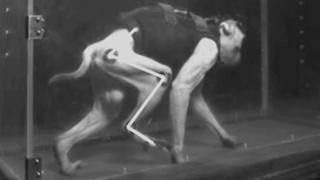 Image copyright EPFL
Image copyright EPFL Researchers were able to make monkeys who suffered from paralysis due to lesions in the spine could resume the movement in one of the legs with the use of a wireless device implanted in the brain.
it Was the first time that the technique has been used with success.
The research, which used rhesus monkeys, was conducted by the Federal Institute of Technology of Switzerland, and published by the scientific journal Nature.
technology has allowed the primates could send commands from the brain to the nerves of one of her legs, which was not possible before due to a spinal injury. (see representation in the image below).
according To the experts, the technology can be tested in humans in a decade.
The paralysis is typically caused by lesions in the spinal cord, that stop the nerve signals sent by the brain to reach out to the members. It is a wound that rarely heals.
In the study, the monkeys had chips implanted in the parts of the brain that control movement.
The devices detect the electrical impulses with the instructions to move the leg and send the data to a computer.
The computer decrypts the messages and sends instructions to another implant, adapted to the spine, which stimulates the nerves in the corresponding through electrical signals.
The process takes place in real time.
The monkeys used in the research regained some control over the leg paralyzed. In six days after the implant, they could walk in a straight line on a treadmill.
“This is the first time that a primate has regained his ability to move through the neurotecnologia,” said Gregoire Courtine, one of the responsible for the study.
“The movement for a walk basic was close to normal, but still not been able to test the ability to change direction,” he said.
the technology used is The same that has been used in therapies to treat Parkinson’s disease. Therefore, a technological advancement to test the technique in human patients would not be necessary.
The complicating factor, according to Courtine, are the biological differences between humans and primates.
“We are bipeds, and this requires more sophisticated ways to stimulate the muscles,” he explained.
For Jocelyne Bloch, neurosurgeon of the University hospital of Lausanne, in Switzerland, the technique is really innovative is the connection between the decoding of the signals emitted by the brain and the stimulation of the spinal cord.
“For the first time I can imagine a patient completely paralyzed being able to move your legs through that interface the brain-spine.”
The use of technology in the recovery of patients who suffer with paralysis is a field that has been developing rapidly.
“Patients with paralysis want to be able to take back real control over their movement, they want to be able to walk,” said Mark Bacon, research director of the NGO Spinal Research.
It commemorates the use of implanted devices and argues that the developments in this field “clearly demonstrate progress.”
Andrew Jackson, a researcher at the University of Newcastle, also sees the developments with optimism:
“it Is quite possible that we may have the first demonstrations clinics of interfaces connecting the spinal cord to the brain until the end of this decade.”
however, Jackson makes the proviso that the monkeys had only one leg paralyzed and are not bipeds like us. Recover movement in two legs would be a much greater challenge, reminded him.
“Locomotion useful also requires control over balance, the ability to change direction and avoid obstacles. And none of these factors was worked by the research,” he stresses.
No comments:
Post a Comment